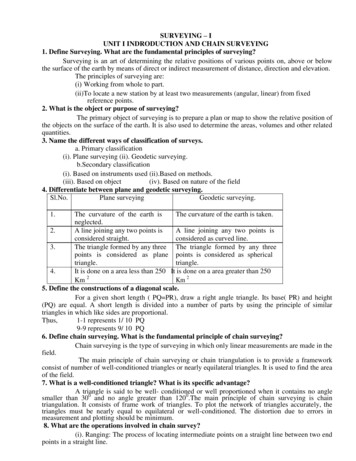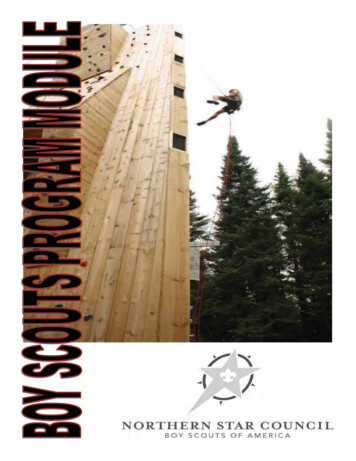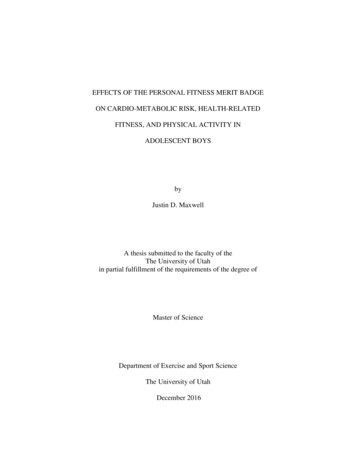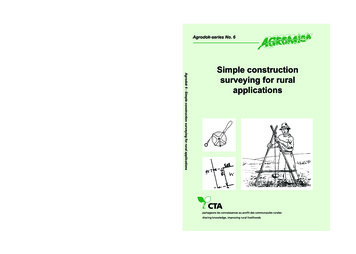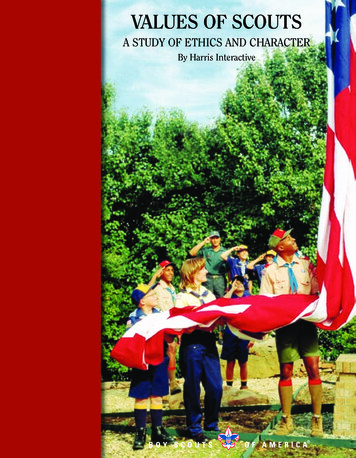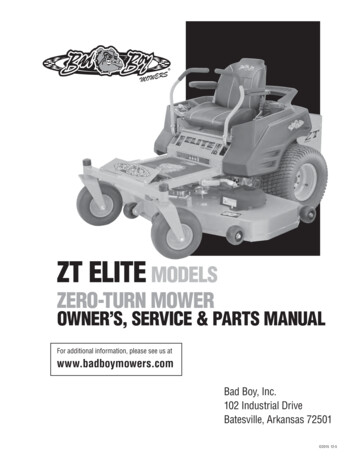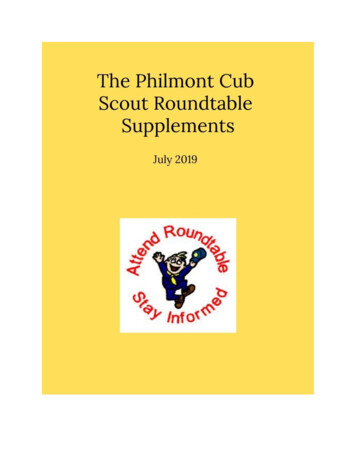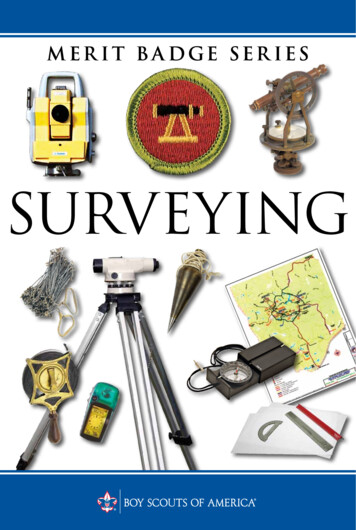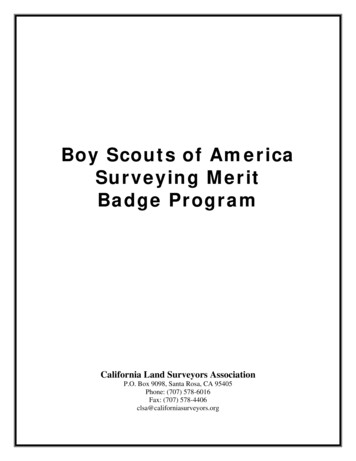
Transcription
Boy Scouts of AmericaSurveying MeritBadge ProgramCalifornia Land Surveyors AssociationP.O. Box 9098, Santa Rosa, CA 95405Phone: (707) 578-6016Fax: (707) 578-4406clsa@californiasurveyors.org
Surveying Merit BadgeContents1. Requirements for Merit Badge .Pg 32. Field Handouts (field notes for scouts) Pg 43. Requirement work sheets .Pg 84. Merit badge counselor registration (sample) .Pg 125. Merit Badge supplemental information. (sample) .Pg 136. Merit Badge Counselor Supplemental Training .Pg 147. Merit Badge Counselor Overview of Obligations .Pg 188. Boy Scouts of America Youth Protection Guidelines .Pg 23Last Revised: 20082 of 26
SURVEYING1.Show that you know first aid for the types of injuries that could occur while surveying, includingcuts, scratches, snakebite, insect stings, tick bites, heat and cold reactions, and dehydration. Explain toyour counselor why a surveyor should be able to identify the poisonous plants and poisonous animalsthat are found in your area.2.Find and mark the corners of a five-sided lot that has been laid out by your counselor to fit theland available. Set an instrument over each of the corners and record the angle turned between each lineand the distance measured between each corner, as directed by your counselor. With the assistance ofthe counselor, compute the error of closure from the recorded notes. The error of closure must not bemore than 5 feet. From the corners, take compass readings or turn angles to trees, shrubs, and rocks andmeasure to them. All measurements should be made using instruments, methods, and accuraciesconsistent with current technology.3.From the field notes gathered for requirement 2, draw to scale a map of your survey. Submit aneatly drawn copy.4.Write a metes and bounds description for the five-sided lot in requirement 2.5.Use one of the corner markers from requirement 2 as a benchmark with an assumed elevation of100 feet. Using a level and rod, determine the elevation of the other four corner markers.6.Get a copy of the deed to your property, or a piece of property assigned by your counselor, fromthe local courthouse or title agency.7.Tell what GPS is; discuss with your counselor the importance of GPS and how it is changing thefield of surveying.8.Discuss the importance of surveying with a licensed surveyor. Also discuss the various types ofsurveying and mapping, and applications of surveying technology to other fields. Discuss careeropportunities in surveying and related fields. Discuss qualifications and preparation for such a career.BSA Advancement ID#: 109 Source: Boy Scout Requirements, #33215a, revised 2005Last Revised: 20083 of 26
SURVEYING MERIT BADGE – Field NotesKEEP(for your records)Name: Date:Field Survey Exercise No. 1(Requirement 2)1. Traverse control loop. Formula used: N – 2 (180 ), N the numbers ofsides. This will give you the correct number of degrees for the interiorof the traverse. You can use this to check your traverse closure.Sketch of Traverse NORTH ARROWStation 1Instrument STA Backsight STA Foresight STA Horizontal Angle 1. 2. Mean Angle Horizontal Distance Last Revised: 20084 of 26
Station 2Instrument STA Backsight STA Foresight STA Horizontal Angle 1. 2. Mean Angle Horizontal Distance Station 3Instrument STA Backsight STA Foresight STA Horizontal Angle 1. 2. Mean Angle Horizontal Distance Station 4Instrument STA Backsight STA Foresight STA Horizontal Angle 1. 2. Mean Angle Horizontal Distance Station 5Instrument STA Backsight STA Foresight STA Horizontal Angle 1. 2. Mean Angle Horizontal Distance Sum of Interior Angles Calculated Sum of Angles Error of Angles Traverse Closure Distance Last Revised: 20085 of 26
Field Survey Exercise No. 1A(Requirement 2)1. Make topographic ties from Traverse station to physical features such astrees, shrubs and rocks. (Azimuth is a compass bearing)BS PtSta PtLast Revised: 2008Azimuth orAngle RightDistanceDescription6 of 26
Name: Date:Field Survey Exercise No. 2(Requirement 5)1. Run elevation levels to all traverse stations. Assume an elevationof 100.00’ at one station and establish elevations on all others.StationB.S.( )H.I.F.S.(-)ElevationDescription100.00Sum Sum The Sum of your backsight and foresight measurements should equal if you have no errors in your level loop.Last Revised: 20087 of 26
MUST BE HANDED IN AT THE END OF DAYScout Name: Unit #: Date:Requirement 2:Find and mark the corners of a five-sided lot that has been laid out by your counselor to fit the land available.Set an instrument over each of the corners and record the angle turned between each line and the distance measured between eachcorner, as directed by your counselor. Record the angles and distances below.Point A to Point BAngle:Distance Between:Point B to Point CAngle:Distance Between:Point C to Point DAngle:Distance Between:Point D to Point EAngle:Distance Between:Point E to Point AAngle:Distance SineLatitudeDepartureTotalsWith the assistance of the counselor, compute the error of closure from the recorded notes. The error of closure must not be morethan 5 feet.Error Of Closure:From the corners, take compass readings or turn angles to trees, shrubs, and rocks and measure to them.From Corner A to: Object: Compass Reading or Angle: Distance:From Corner B to: Object: Compass Reading or Angle: Distance:From Corner C to: Object: Compass Reading or Angle: Distance:From Corner D to: Object: Compass Reading or Angle: Distance:From Corner E to: Object: Compass Reading or Angle: Distance:All measurements should be made using instruments, methods, and accuracies consistent with current technology, as directed byyour counselor.Give a brief summary of the procedure and what you learned:Tell about the instruments you used, their names and main functions.Instrument: Main Function:Instrument: Main Function:Last Revised: 2008Last Revised: 20088 of 26
Scout Name: Unit #: Date:Requirement: 3From the field notes gathered for requirement 2, draw to scale a map of your survey (as directed by your counselor). Submit a neatlydrawn copy. The map should include: North Arrow, Scale of Drawing, Traverse, and Topographic items, use your skills to make a map.Use the remainder of this page to draw your map. You can put your final copy here, or use the area for a rough sketch. If you use otherpaper for you map, attach them to this worksheet when you are finished.Revised: 2008Last Revised: 20089 of 26
Scout Name: Unit #: Date:Requirement 5Use one of the corner markers from requirement 2 as a benchmark with an assumed elevation of 100 feet. Using a level rod,determine the elevation of the other four corner markers.Marker 1 Elevation: 100.00 FeetMarker 2 Elevation:Marker 4 Elevation:Marker 5 Elevation:Marker 3 Elevation:Give a brief explanation of how you were able to determine the elevation of the other markers:Requirement 4Write a metes (measurements) and bounds (boundaries) legal description for your five sided figure that you surveyed earlier:Scout Name: Unit #: Date:Last Revised: 200810 of 26
Requirement 6Discuss the importance of surveying with a licensed surveyor or another qualified individual. Tell what you learned:Also discuss the various types of surveying and mapping, and applications of surveying technology to other fields. Tell what youlearned:Discuss career opportunities in surveying and related fields. What career opportunities did you find?Discuss the qualifications and preparation for such a career. Include the kind of degree or education you may need to have. Andalso include the names of classes you may want to take in high school to help you prepare for a career in this field:Last Revised: 200811 of 26
SampleLast Revised: 200812 of 26
SampleLast Revised: 200813 of 26
Merit Badge Counselor OrientationSUPPLEMENTAL ADULT LEADER TRAININGPURPOSEThe purpose of this training unit is to provide council- or district-approved and registered merit badgecounselors with understanding of the methods of counseling and their role in the advancementprogram of the Boy Scouts of America.The merit badge counselor's role is to bring about learning on the part of the Boy Scout.As a "coach" the counselor advises the Scout concerning steps he should take to fulfill the requirementsfor the merit badge.As a "counselor" he evaluates the Scout's performance and determines whether or not the Scout has metthe prescribed objectives in the requirements.OBJECTIVESAs a result of this unit of training, the merit badge counselor should be able toooooState the purpose of the merit badge program for Scouts.Explain the role of the merit badge counselor.List some methods of counseling and coaching.Use the buddy system for counseling.REFERENCESoooooBoy Scout RequirementsAdvancement Policies and Procedures Committee GuideMerit Badge CounselingApplication for Merit BadgeBoy Scout HandbookSCOUT BUDDY SYSTEMA Scout must have a buddy with him at each meeting with a merit badge counselor. A Scout's buddycould be another Scout, or be a parent or guardian, brother or sister, relative or friend. The Scoutobtains a signed Application for Merit Badge and the name of the appropriate merit badge counselorfrom his Scoutmaster. The Scout sets up his first appointment with the counselor. At this first meetingwith the Scout and his buddy, the counselor should explain to the Scout what is expected to startLast Revised: 200814 of 26
meeting the requirements. When the Scout knows what is expected, he can start to learn and do thethings required. The counselor will help the Scout learn the things he needs to know or do.When the Scout is ready, he should call the counselor again and make an appointment for him and hisbuddy to meet with the counselor and begin to meet the requirements. He should take along with himthe things he has made to meet the requirements. The counselor will ask him to do each requirementto make sure he knows his stuff and has done or can do the things required.When the counselor is satisfied that the requirements have been met, he or she will sign theApplication for Merit Badge, keeping the third section and returning the first two sections to the Scout.The Scout turns in both sections of the Application for Merit Badge to his Scoutmaster so the meritbadge can be secured.STATEMENTA Scout earns a merit badge by working with a council/district-approved and registered adultcounselor, an expert in the chosen subject, who is on the list provided to his troop from the district. TheScout, along with a buddy, makes an appointment with the counselor and works on the merit badgewith the counselor during one or more visits. When the counselor approves the Scout's application, theScoutmaster submits it to the council service center and obtains the badge. As with rank awards, theScout is awarded the merit badge at the next troop meeting, and later at the next court of honor.Any registered Scout, regardless of rank, may work on any merit badge and receive the award whenhe earns it.The merit badge program is one of Scouting's basic character-developing tools. Earning merit badgesgives boys the kind of self-confidence that comes only from overcoming obstacles to achieve a goal.Through the merit badge program, boys learn career skills that might help them choose their lifework. Some merit badges help boys develop physical fitness and provide hobbies that give a lifetimeof healthful recreation.Working with a merit badge counselor gives the Scouts contact with an adult with whom they might notbe acquainted. This is a valuable experience. The Scouts could be shy and fearful in this new situation,so the counselor must see that the counseling session is relaxed, informal, and friendly.Although at times two Scouts will be working as buddies on the same merit badge, each Scout isjudged on his own performance of the requirements and should receive the maximum benefit from theknowledge, skill, character, and personal interest of the counselor. Group instruction and orientationare encouraged where special facilities and expert personnel make this most practical or when Scoutsare dependent on a few counselors for assistance. However, this group experience should includeindividual attention to each candidate's projects and his ability to fulfill all requirements.Last Revised: 200815 of 26
READ AND DISCUSSThe pamphlet, Merit Badge CounselingDISCUSS THESE POINTS WITH THE MERIT BADGE COUNSELOR1.2.Merit badge requirements in the merit badge pamphlet.Merit badge pamphlets are available in each subject anda.May be purchased by the Scout.b.May be available at a library.c.May be in the troop library.3. The Scout indicates his interest in a merit badge to his Scoutmaster, who gives hima.An interview to determine interest, enthusiasm, preparedness.b.A signed Application for Merit Badge.c.The name and phone number of the council/district-approved counselor.d.Encouragement to wear the official uniform when he visits the counselor with a buddy.4.The Scout calls the merit badge counselor and makes an appointment.5.The merit badge counselor sets the date and time for the Scout and his buddy and suggests theScout bring the following:a.Merit badge pamphletb.Merit badge applicationc.Any projects he may have startedd.Any other indication of preparedness6. At the first interview, the merit badge counselor and the Scout decide upona.Projects.b.Short-term and long-term goals with dates of completion in mind.c.Dates and times for future sessions.7.The number of counseling sessions depends on the difficulty of the subject and the presentationand ability of the Scout.8.The Scout is counseled with a buddy present.9.The Scout is always tested individually but with a buddy present, and as eachrequirement is completed the counselor marks it on the application.10.The Scout is expected to meet the requirements as stated -- no more and no less.11.The merit badge counselor assists the Scout to meet the requirements and certifies when he hascompleted them.Last Revised: 200816 of 26
COUNSELING TECHNIQUES1.For the Scout to get the most benefit from the counseling session, he must feel welcome andrelaxed. One way for the counselor to put him at ease is to ask a simple question. For example, "Howlong have you been in Scouting?" or "What got you interested in the astronomy merit badge?"2.Another way to put a Scout at ease is to show him something related to the merit badge subject.For example, a Coin Collecting merit badge counselor might show the Scout his coin collection.However, don't overwhelm the Scout. Remember, he is probably a beginner.3.A third way to put a Scout at ease is to ask him to do a simple skill. For example, a Woodworkmerit badge counselor might say, "Would you sand this piece of wood while I get some tools ready?"4.At the first meeting with the Scout, the merit badge counselor should carefullyreview each requirement to be sure the Scout understands what he must do.5.Before the merit badge counselor signs the Scout's Application for Merit Badge, he must insistthat the Scout do exactly what the requirements call for. If it says, "show or demonstrate," that is whathe must do. Just telling isn't enough. The same things hold true for words such as "make," "list," "in thefield," and "collect, identify, and label."6.On the other hand, you cannot require more of a Scout than stated. You must not, for example,say, "I want to be sure you really know your stuff, so instead of the 20 items you need for the collection,you must have 30 to get my signature."7.It is, of course, acceptable for the Scout on his own initiative to do more than the requirementscall for.8.When reviewing the requirements with a Scout or testing him, the merit badge counselor mayfind that the boy needs help in learning a particular skill. One of the jobs of a merit badge counselor is toteach the Scout the skills required.9.The most effective way to teach a skill is to get the Scout to practice while learning.AS A COUNSELOR1.A Scout is interviewed with a buddy present to determinea.His preparedness.b.The amount of knowledge he already has in the subject.c.His interest in the subject.2.Short-term and long-term goals are set by the Scout with encouragement from the counselor.3.Counselor follows up with the Scout on his goals -- projects, collections, written work.4.Counselor helps the Scout evaluate his progress.5.Counselor encourages the Scout to ask for any help he needs to gain moreknowledge or skill in the subject.Last Revised: 200817 of 26
As a COACH1.Teaches the Scout the skills required2.Gives the Scout an opportunity to practice the skills under his or her guidance3.Takes a genuine interest in the projects and encourages completionREQUIREMENTSCheck over the requirements for the merit badge(s) each counselor will be using. (Have the counselorsdo this individually.)MERIT BADGE LIBRARYA listing of all merit badge pamphlets can be found on the inside back cover of the current BoyScout Requirements.Source: Merit Badge Counselor Orientation, Supplemental Adult Leader Training, #34542 (1995)Merit Badge CounselingThe merit badge program is part of the advancement plan of the Boy Scouts of America. It has guidedthe interests and energies of Boy Scouts for 85 years and is one of the most unusual educationalprograms ever devised. A merit badge is an award that is presented to a Boy Scout or Varsity Scoutwhen he has completed the requirements for one of more than 100 subjects in a wide variety of art, craft,hobby, sport, trade, profession, agribusiness, service, or self-improvement areas. The badge is only asmall piece of cloth with a design embroidered in color -- but its significance is as large as the interest ofthe merit badge counselor who helps a Scout earn it.This could not have happened without the service of thousands of merit badge counselors -- likeyourself -- expert in a particular subject and interested in helping Scouts grow into men of character,ready to take their place in the world of work as participating citizens. You're probably saying,"That's all great, but what do I do, and how do I do it?"WHAT'S MY JOB?Your job is to satisfy yourself that each Scout who comes to you meets all the requirements for themerit badge. In this sense you are an examiner. But, your larger opportunity ties in coaching -Last Revised: 200818 of 26
helping the Scout over the different hurdles of the requirements and making him aware of thedeeper aspects of the subject from your knowledge and experience.WHAT DO I AGREE TO?As a merit badge counselor, I agree to:Follow the requirements of the merit badge, making no deletions or additions,ensuring that the advancement standards are fair and uniform for all Scouts.Have a buddy present with each Scout at all instructional sessions.Renew my registration as a merit badge counselor annually if I plan to continueserving as a merit badge counselor.EARNING A MERIT BADGEThese are the steps that a Scout takes to earn a merit badge, as outlined in the Boy Scout Handbook.Gets a signed merit badge application from his Scoutmaster or Varsity Scout Coach and finds a buddy who canattend the merit badge counselor meetings with him. (His buddy can be another Scout, a parent or guardian, abrother or sister, or a relative or friend.)Gets the merit badge pamphlet on his subject. His patrol or troop may have one he can borrow. So may the library.Or he may purchase one from the local council service center. Contacts the merit badge counselor and explains thathe would like to earn the badge. Along with his buddy, meets the counselor and discusses how he can get the mostout of the time he spends working on the badge.Learns and does the things that the pamphlet explains. Goes as far as he can to fulfill the requirements on his own.When he is ready, he and his buddy make another appointment with the counselor. The counselor will spend timewith him going over the important parts of the subject. A good counselor will also help him see beyond therequirements and discover ways to continue learning about the subject. If the counselor is satisfied that the Scouthas completed the requirements, he will sign the merit badge form. If not, the counselor will explain what he stillmust do. Gives the signed form to his Varsity Scout Coach or Scoutmaster.The Varsity Scout Coach or Scoutmaster will get the badge for him and present it to him during a troop ceremony.HOW DOES THIS RELATE TO YOU?1.The Scout should bring a merit badge application signed by his Scoutmaster or Varsity ScoutCoach on his first visit to you. He must be accompanied by a buddy.2.The Scout contacts you, probably by phone. You may tell him what is expected of him over thephone, or you may want to make an appointment to discuss this with him face-to-face. Personal contactwill make earning the badge a better experience for both you and the Scout.3.In your discussion of what is expected, you may want to start by finding out from the boy whathe already knows, so you can spend your time on helping him learn the remaining items, or giveguidance in completing projects. You can set up additional meetings with the Scout -- not only for theLast Revised: 200819 of 26
purpose of passing him on the requirements, but rather to help him in his understanding of the subject.4.The Scout, along with his buddy, should make another appointment with youwhen he thinks he is prepared to prove his ability. You set the date, time, andplace.5.This review session will be approached by the Scout with some apprehension. He is familiar withfinal exams in school and may look on this meeting with you as another such experience. You can help agreat deal by putting the boy at ease.Talk with him rather than examine him. There is a big difference, yet you can find out what theboy knows. Express honest enthusiasm for the things he has done, particularly if projects are involved.Your approval will give confidence to the Scout.6.When he meets you, he should bring with him the projects required for completion. If the thingshe has done cannot be transported, he should present you with satisfactory evidence, such as aphotograph of the project or adult certification. His Scoutmaster or Varsity Scout Coach might, forexample, certify that a satisfactory bridge or tower has been built for Pioneering, or that the requiredmeals were prepared for the Cooking merit badge. Your job, in addition to coaching, is to satisfyyourself that the requirements have been met. Question the Scout and, if you have my doubts, contactthe adult who signed the statement.7.When you are satisfied that the Scout has met the requirements, you sign his merit badgeapplication.You may work with many Scouts each year as they earn merit badges. However, you may only workwith a few. Your contact with these Scouts is tremendously important. Your influence is measured notby how many Scouts you work with, but the effect upon the lives of those you have the opportunity towork with.Throughout your association with the Scout, keep in mind that you are in reality assisting theScoutmaster, the Varsity Scout Coach, and other troop and team leaders in the program of advancementwhich the Scoutmaster or Varsity Scout Coach helps each of his Scouts plan. Often, the Scoutmaster orVarsity Scout Coach will help the Scout select the merit badges he will earn for a particular award.Whether he does or not, he is always interested in the Scout's progress. You should feel free to discusshis work with the Scoutmaster or Varsity Scout Coach at any time.MORE OR LESS?The Scout is expected to meet the requirements as stated -- no more and no less. Furthermore, he is todo exactly what is stated. If it says "show or demonstrate," that is what he must do. Just telling about itisn't enough. The same thing holds true for such words as "make," "list," "in the field," and "collect,identify, and label."On the other hand, you cannot require more of a Scout than stated. You must not, for example, say, "Iwant to be sure you really know your stuff, so instead of the 20 items in your collection, you must have50 to get my signature." You can suggest, encourage, and help the Scout to get 50 things, but you mustnot require it.You might wonder, then, if the requirements as stated are the limits, what there is for you to do otherLast Revised: 200820 of 26
than help the Scout with the specifies of these requirements. Actually, you can go far beyond them inyour discussions with the Scout. He probably will welcome your willingness to share with him yourknowledge well beyond the requirements, and you will be making a real contribution to him by doingso. But it isn't required. That's the key. The Scout does not have to show his knowledge of those thingsbeyond the requirements.You might stress the fact that while knowledge is necessary, whether he can put his knowledge to workis the important thing in life. As you work with the Scout you can give him indirect career guidance.Many merit badge subjects can acquaint a Scout with the job opportunities in various fields, In thesecases the merit badge work is a real exploration in an adult work experience, showing him whether ornot he has the interest or ability along such lines. His activity also can show him what educationalrequirements a subject area has. You can provide the Scout with valuable information on jobpossibilities, show him what is most interesting to you and what is difficult. The final choice -- theselection of what he is going to do with himself in life -- is up to one person. That person is the Scouthimself. However, he will appreciate your help in showing him the relationship of his merit badgework to his life as he goes to school, into business or a trade, and on into adult life.WHERE DO YOU MEET?If the merit badge subject relates to your job or profession, then your place of work is probably theplace to meet with Scouts.Subjects that are related to your hobbies usually will be handled in your home. Here you will havehobby-related materials to use in your coaching of Scouts. For a few subjects, coaching will happen inthe field or where special equipment is at hand. Rowing, Rifle Shooting, Swimming, and Astronomy aregood examples.HOW MANY AT A TIME?Frequently the skills of a subject can he taught to several Scouts at one time. This has a time advantagefor you. However, the completing of the requirements always must be done on an individual basis.Scouts may not qualify for merit badges by just being members of a group that is instructed in skills.They must qualify by personally satisfying you that they can meet all the requirements. It's pretty hardto do this in a group. When one Scout in a group answers a question it can't possibly prove that all theothers in the group also know the answer. Then, too, each Scout learns at his own pace. He should notbe held back or pushed ahead by his association with a group.So remember -- you can coach more than one at a time, but only one Scout at a time can satisfy youthat he can meet the requirements.CAN YOU SELL YOUR SUBJECT?Scout troops and Varsity Scout teams are constantly seeking program material for meetings. If youLast Revised: 200821 of 26
would like to expand interest in your subject and to attract more Scouts to earn the merit badge, contactScoutmasters and Varsity Scout Coaches in your area and offer to come to a troop or team meeting to"sell your subject." All Scouts won't be interested in the subject, so plan an exciting 10- or 15-minutepresentation designed to tickle the fancy of your audience. Then, offer to meet with those who are reallyinterested after the meeting to plan for your next get-together.DO YOU NEED A MERIT BADGE PAMPHLET?The information in the pamphlet is probably familiar to you, but it will help you to know what the Scoutis told. They are written for Scout-age boys. They also contain suggestions for projects that might giveyou ideas for being helpful.It's a good idea to obtain the latest printing of the pamphlet on your subject. It will contain the latestrequirements and information on meeting them. The printing date is in each pamphlet.A complete list of merit badge pamphlets is printed on the inside back cover of all pamphlets with thelatest revision date of each. By checking this list in any current year's pamphlet, you can find outwhether your pamphlet is updated. Most pamphlets are reprinted each year, and the contents areupdated periodically.If you have suggestions for improvements in the requirements or pamphlet, please send yourcomments to: Boy Scout Division, Boy Scouts of America, 1325 West Walnut Hill Lane, P.O. Box 152079,Irving, TX 75015-2079.Last Revised: 200822 of 26
BOY SCOUTS OF AMERICAYOUTH PROTECTION GUIDELINESQUESTIONS AND ANSWERSWhat is child abuse?Generally speaking, child abuse is injury of a child by an adult or older child that might not be intentional, but is not accidental. It is usuallyclassified as physical abuse, emotional abuse, or sexual abuse. Harm caused by withholding life’s necessities—food, clothing, shelter, medicalcare, education—is called neglect.How can I tell if-a child has
Boy Scouts of America Surveying Merit Badge Program California Land Surveyors Association P.O. Box 9098, Santa Rosa, CA 95405 Phone: (707) 578-6016 . Scout is awarded the merit badge at the next troop meeting, and later at the next court of honor. Any registered Scout, regardless of rank, may work on any merit badge and receive the award when .
